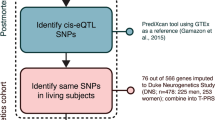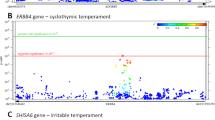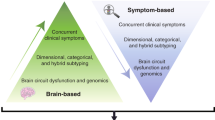Abstract
Carriers of the short allele of a functional 5′ promoter polymorphism of the serotonin transporter gene have increased anxiety-related temperamental traits, increased amygdala reactivity and elevated risk of depression. Here, we used multimodal neuroimaging in a large sample of healthy human subjects to elucidate neural mechanisms underlying this complex genetic association. Morphometrical analyses showed reduced gray matter volume in short-allele carriers in limbic regions critical for processing of negative emotion, particularly perigenual cingulate and amygdala. Functional analysis of those regions during perceptual processing of fearful stimuli demonstrated tight coupling as a feedback circuit implicated in the extinction of negative affect. Short-allele carriers showed relative uncoupling of this circuit. Furthermore, the magnitude of coupling inversely predicted almost 30% of variation in temperamental anxiety. These genotype-related alterations in anatomy and function of an amygdala-cingulate feedback circuit critical for emotion regulation implicate a developmental, systems-level mechanism underlying normal emotional reactivity and genetic susceptibility for depression.
This is a preview of subscription content, access via your institution
Access options
Subscribe to this journal
Receive 12 print issues and online access
$209.00 per year
only $17.42 per issue
Buy this article
- Purchase on Springer Link
- Instant access to full article PDF
Prices may be subject to local taxes which are calculated during checkout




Similar content being viewed by others
References
Nemeroff, C.B. & Owens, M.J. Treatment of mood disorders. Nat. Neurosci. 5 (suppl.), 1068–1070 (2002).
Wong, M.L. & Licinio, J. Research and treatment approaches to depression. Nat. Rev. Neurosci. 2, 343–351 (2001).
Gaspar, P., Cases, O. & Maroteaux, L. The developmental role of serotonin: news from mouse molecular genetics. Nat. Rev. Neurosci. 4, 1002–1012 (2003).
Gross, C. & Hen, R. The developmental origins of anxiety. Nat. Rev. Neurosci. 5, 545–552 (2004).
Ansorge, M.S., Zhou, M., Lira, A., Hen, R. & Gingrich, J.A. Early-life blockade of the 5-HT transporter alters emotional behavior in adult mice. Science 306, 879–881 (2004).
Lesch, K.P. et al. Association of anxiety-related traits with a polymorphism in the serotonin transporter gene regulatory region. Science 274, 1527–1531 (1996).
Murphy, D.L., Lerner, A., Rudnick, G. & Lesch, K.P. Serotonin transporter: gene, genetic disorders, and pharmacogenetics. Mol. Interv. 4, 109–123 (2004).
Schinka, J.A., Busch, R.M. & Robichaux-Keene, N. A meta-analysis of the association between the serotonin transporter gene polymorphism (5-HTTLPR) and trait anxiety. Mol. Psychiatry 9, 197–202 (2004).
Sen, S., Burmeister, M. & Ghosh, D. Meta-analysis of the association between a serotonin transporter promoter polymorphism (5-HTTLPR) and anxiety-related personality traits. Am. J. Med. Genet. B Neuropsychiatr. Genet. 127, 85–89 (2004).
Lotrich, F.E. & Pollock, B.G. Meta-analysis of serotonin transporter polymorphisms and affective disorders. Psychiatr. Genet. 14, 121–129 (2004).
Caspi, A. et al. Influence of life stress on depression: moderation by a polymorphism in the 5-HTT gene. Science 301, 386–389 (2003).
Kendler, K.S., Kuhn, J. & Prescott, C.A. The interrelationship of neuroticism, sex, and stressful life events in the prediction of episodes of major depression. Am. J. Psychiatry 161, 631–636 (2004).
Eley, T.C. et al. Gene-environment interaction analysis of serotonin system markers with adolescent depression. Mol. Psychiatry 9, 908–915 (2004).
Murphy, G.M. Jr., Hollander, S.B., Rodrigues, H.E., Kremer, C. & Schatzberg, A.F. Effects of the serotonin transporter gene promoter polymorphism on mirtazapine and paroxetine efficacy and adverse events in geriatric major depression. Arch. Gen. Psychiatry 61, 1163–1169 (2004).
Hariri, A.R. et al. Serotonin transporter genetic variation and the response of the human amygdala. Science 297, 400–403 (2002).
Hariri, A.R. et al. A susceptibility gene for affective disorders and the response of the human amygdala. Arch. Gen. Psychiatry 62, 146–152 (2005).
Heinz, A. et al. Amygdala-prefrontal coupling depends on a genetic variation of the serotonin transporter. Nat. Neurosci. 8, 20–21 (2005).
Whalen, P.J. et al. Human amygdala responsivity to masked fearful eye whites. Science 306, 2061 (2004).
Good, C.D. et al. A voxel-based morphometric study of ageing in 465 normal adult human brains. Neuroimage 14, 21–36 (2001).
Ashburner, J. & Friston, K.J. Voxel-based morphometry–the methods. Neuroimage 11, 805–821 (2000).
Pezawas, L. et al. The brain-derived neurotrophic factor val66met polymorphism and variation in human cortical morphology. J. Neurosci. 24, 10099–10102 (2004).
Drevets, W.C. et al. Subgenual prefrontal cortex abnormalities in mood disorders. Nature 386, 824–827 (1997).
Phillips, M.L., Drevets, W.C., Rauch, S.L. & Lane, R. Neurobiology of emotion perception II: Implications for major psychiatric disorders. Biol. Psychiatry 54, 515–528 (2003).
Paus, T. Primate anterior cingulate cortex: where motor control, drive and cognition interface. Nat. Rev. Neurosci. 2, 417–424 (2001).
Ramnani, N., Behrens, T.E., Penny, W. & Matthews, P.M. New approaches for exploring anatomical and functional connectivity in the human brain. Biol. Psychiatry 56, 613–619 (2004).
Meyer-Lindenberg, A. et al. Evidence for abnormal cortical functional connectivity during working memory in schizophrenia. Am. J. Psychiatry 158, 1809–1817 (2001).
Friston, K.J., Frith, C.D., Liddle, P.F. & Frackowiak, R.S. Functional connectivity: the principal-component analysis of large (PET) data sets. J. Cereb. Blood Flow Metab. 13, 5–14 (1993).
Cloninger, C.R., Svrakic, D.M. & Przybeck, T.R. A psychobiological model of temperament and character. Arch. Gen. Psychiatry 50, 975–990 (1993).
Reif, A. & Lesch, K.P. Toward a molecular architecture of personality. Behav. Brain Res. 139, 1–20 (2003).
Drevets, W.C. et al. Glucose metabolism in the amygdala in depression: relationship to diagnostic subtype and plasma cortisol levels. Pharmacol. Biochem. Behav. 71, 431–447 (2002).
Mayberg, H.S. et al. Reciprocal limbic-cortical function and negative mood: converging PET findings in depression and normal sadness. Am. J. Psychiatry 156, 675–682 (1999).
Drevets, W.C., Bogers, W. & Raichle, M.E. Functional anatomical correlates of antidepressant drug treatment assessed using PET measures of regional glucose metabolism. Eur. Neuropsychopharmacol. 12, 527–544 (2002).
Mayberg, H.S. et al. Regional metabolic effects of fluoxetine in major depression: serial changes and relationship to clinical response. Biol. Psychiatry 48, 830–843 (2000).
Wu, J.C., Buchsbaum, M. & Bunney, W.E., Jr. Clinical neurochemical implications of sleep deprivation's effects on the anterior cingulate of depressed responders. Neuropsychopharmacology 25, S74–S78 (2001).
Dougherty, D.D. et al. Cerebral metabolic correlates as potential predictors of response to anterior cingulotomy for treatment of major depression. J. Neurosurg. 99, 1010–1017 (2003).
Mega, M.S., Cummings, J.L., Salloway, S. & Malloy, P. The limbic system: an anatomic, phylogenetic, and clinical perspective. J. Neuropsychiatry Clin. Neurosci. 9, 315–330 (1997).
Varnas, K., Halldin, C. & Hall, H. Autoradiographic distribution of serotonin transporters and receptor subtypes in human brain. Hum. Brain Mapp. 22, 246–260 (2004).
Stefanacci, L. & Amaral, D.G. Some observations on cortical inputs to the macaque monkey amygdala: an anterograde tracing study. J. Comp. Neurol. 451, 301–323 (2002).
Maren, S. & Quirk, G.J. Neuronal signalling of fear memory. Nat. Rev. Neurosci. 5, 844–852 (2004).
Sotres-Bayon, F., Bush, D.E. & LeDoux, J.E. Emotional perseveration: an update on prefrontal-amygdala interactions in fear extinction. Learn. Mem. 11, 525–535 (2004).
Rosenkranz, J.A., Moore, H. & Grace, A.A. The prefrontal cortex regulates lateral amygdala neuronal plasticity and responses to previously conditioned stimuli. J. Neurosci. 23, 11054–11064 (2003).
Haydon, P.G., McCobb, D.P. & Kater, S.B. Serotonin selectively inhibits growth cone motility and synaptogenesis of specific identified neurons. Science 226, 561–564 (1984).
Keightley, M.L. et al. Personality influences limbic-cortical interactions during sad mood induction. Neuroimage 20, 2031–2039 (2003).
Carmichael, S.T. & Price, J.L. Limbic connections of the orbital and medial prefrontal cortex in macaque monkeys. J. Comp. Neurol. 363, 615–641 (1995).
Ghashghaei, H.T. & Barbas, H. Pathways for emotion: interactions of prefrontal and anterior temporal pathways in the amygdala of the rhesus monkey. Neuroscience 115, 1261–1279 (2002).
Amaral, D.G. & Price, J.L. Amygdalo-cortical projections in the monkey (Macaca fascicularis). J. Comp. Neurol. 230, 465–496 (1984).
Shirao, N., Okamoto, Y., Mantani, T., Okamoto, Y. & Yamawaki, S. Gender differences in brain activity generated by unpleasant word stimuli concerning body image: an fMRI study. Br. J. Psychiatry 186, 48–53 (2005).
Egan, M.F. et al. Effect of COMT Val108/158 Met genotype on frontal lobe function and risk for schizophrenia. Proc. Natl. Acad. Sci. USA 98, 6917–6922 (2001).
Friston, K.J. et al. Statistical parametric maps in functional imaging: a general linear approach. Hum. Brain Mapp. 2, 189–210 (1994).
Meyer-Lindenberg, A. et al. Neural basis of genetically determined visuospatial construction deficit in Williams syndrome. Neuron 43, 623–631 (2004).
Acknowledgements
We thank A. Goldman and P. Fisher for technical assistance and H. S. Mayberg for comments on the manuscript. Furthermore, we thank T.E. Goldberg for providing psychological data and J.H. Callicott for support of data acquisition. This work was supported by the US National Institute of Mental Health Intramural Research Program.
Author information
Authors and Affiliations
Corresponding author
Ethics declarations
Competing interests
The authors declare no competing financial interests.
Supplementary information
Supplementary Figure 1
Unmasked and thresholded (t > 2) statistical map of reported subgenual anterior cingulate cortex volume reduction in S carriers in comparison to LL genotype. Slices in axial view are displayed from superior (top left corner) to inferior (bottom right corner) in 1 mm steps. Color scale represents t-scores. This map highlights the spatial dimension of volume reductions found in S carriers within the subgenual anterior cingulate cortex, which is the location of maximal volume reductions in S carriers in comparison to LL genotype. (JPG 32 kb)
Supplementary Figure 2
Spatial relationship between regions of interest (ROIs) used in a study by Heinz et al.1 and our study. Both ROIs are projected on the left hemisphere and do not cover the same medial prefrontal brain regions. It is noteworthy that the area of the subgenual cingulum, where we found maximal statistical differences is not covered by the ROI used by Heinz et al. The ROI used by Heinz et al was reconstructed by using a 36 mm diameter sphere centered between the genu of the corpus callosum and the anterior pole (x, y, z = 0, 52, -3) as reported 1. In our study, we used a ROI, which was based on observed volumetric effects in S allele carriers in comparison to LL genotype (see methods section for details). Axis dimensions represent Talairach space. (JPG 20 kb)
1. Heinz, A. et al. Amygdala-prefrontal coupling depends on a genetic variation of the serotonin transporter. Nat Neurosci 8, 20-1 (2005).
Supplementary Figure 3
Statistical functional connectivity maps between bilateral amygdala and the ROI used by Heinz et al.1 display degree of functional coupling between these structures (n = 94) with respect to genotype (color bar representing t-scores). Blue areas (negative t-scores) indicate that 5-HTTLPR S allele carriers show higher functional coupling between amygdala and this spherical ROI than LL individuals similar to findings reported by Heinz et al. 1. Positive t-scores represent the inverse relationship. Statistics remain non-significant after correction for multiple comparisons within this ROI. (JPG 28 kb)
1. Heinz, A. et al. Amygdala-prefrontal coupling depends on a genetic variation of the serotonin transporter. Nat Neurosci 8, 20-1 (2005).
Supplementary Figure 4
Diagram summarizing functional connectivity analyses and effects of genotype in context of available knowledge about anatomical pathways. Carriers of the S allele show a marked diminished functional connectivity between amygdala and anterior subgenual cingulate cortex in comparison to LL genotype; amygdala-supragenual anterior cingulate connectivity is also reduced, but less so. Genotype had no effect on subgenual-supragenual anterior cingulate connectivity. The direction of arrows is based on anatomical tracing studies of principle projection paths. (JPG 57 kb)
Supplementary Table 1
Correlation analysis of regional volume and BOLD signal (n = 26). (PDF 54 kb)
Supplementary Table 2
Functional connectivity between subgenual (reference region) and supragenual anterior cingulate cortex (target region). (PDF 70 kb)
Supplementary Table 3
Correlation analysis of imaging data with behavioral data (n = 26). (PDF 56 kb)
Supplementary Table 4
Functional connectivity between subgenual cingulate (reference region) and bilateral ventromedial prefrontal regions (target region) reported by Heinz et al.1 (PDF 72 kb)
Supplementary Table 5
Demographic information for subjects included in structural (n = 114) and functional (n = 94) analyses. (PDF 59 kb)
Rights and permissions
About this article
Cite this article
Pezawas, L., Meyer-Lindenberg, A., Drabant, E. et al. 5-HTTLPR polymorphism impacts human cingulate-amygdala interactions: a genetic susceptibility mechanism for depression. Nat Neurosci 8, 828–834 (2005). https://doi.org/10.1038/nn1463
Received:
Accepted:
Published:
Issue Date:
DOI: https://doi.org/10.1038/nn1463
This article is cited by
-
Integrative omics analysis reveals epigenomic and transcriptomic signatures underlying brain structural deficits in major depressive disorder
Translational Psychiatry (2024)
-
Causation in neuroscience: keeping mechanism meaningful
Nature Reviews Neuroscience (2024)
-
A network model of depressive and anxiety symptoms: a statistical evaluation
Molecular Psychiatry (2024)
-
Emotion dysregulation, impulsivity and anger rumination in borderline personality disorder: the role of amygdala and insula
European Archives of Psychiatry and Clinical Neuroscience (2024)
-
Disentangling the personality pathways to well-being
Scientific Reports (2023)



